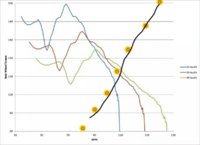This same general topic tends to show up a few times a year, and every time there's a whole bunch of "answers", but I'm still left wondering what the real question is...
My '74 has a fairly mild tune: decent exhaust, good carbs, PAMCO, and I keep it tuned up and well-adjusted. Otherwise entirely stock all-original engine internals.
I run a 17/32 final drive. The bike pulls 5k rpm at 60mph with no overwhelming vibration. Yes, I spend more time in 4th gear now than I did with 17/34 gearing, but the ability to trundle around in a high-gear low-noise low-vibe mode is worth it to me. My new rear wheel is being built with a 33-tooth sprocket to try and split the difference.
Cruises on the freeway at 80mph and will do the ton, but I seldom ask it to. Acceleration is brisk enough to be entertaining when running up through the gears, but more importantly, 30-70mph top-gear roll-ons are even more satisfying! Lugging torque from 2500rpm out of an "antique" twin that will still breathe at 8k? Yes, thank-you.
Still, I'm comfortable with it being no modern wonder-bike, and I happily accept the compromises.
I can't help but think that the solution to many "More Power AND Higher Top End" and/or "My Bike Struggles To Go 80" questions is simply careful maintenance, valve adjustments, carb jetting/balancing, tire pressure monitoring, and the like.



